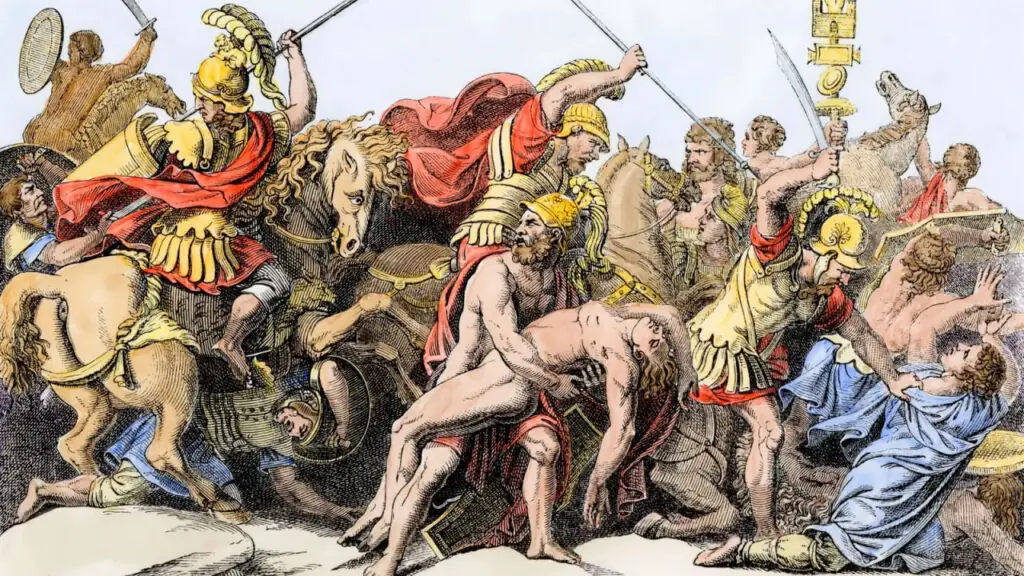Did the Greeks really use a giant wooden horse to sneak into Troy, or is it just a story? Let’s dive into this ancient mystery and see what’s myth and what might be real.

✅ AI Essay Writer ✅ AI Detector ✅ Plagchecker ✅ Paraphraser
✅ Summarizer ✅ Citation Generator
The tale of the Trojan Horse is one of cunning strategy and epic battles, a story that has fascinated generations. But was this legendary horse a real piece of ancient warfare or just a myth? As we peel back layers of history, mythology, and archaeology, let’s explore the evidence and theories surrounding the existence of the Trojan Horse.
The Tale As Old As Time
The story of the Trojan Horse comes from ancient Greek mythology, detailing a clever ploy by the Greeks to enter the fortified city of Troy and end a decade-long war. According to the legend, the Greeks built a massive wooden horse, hid soldiers inside, and tricked the Trojans into bringing it into their city as a gift. Once inside, the Greek soldiers emerged and opened the gates for their army, leading to Troy’s downfall.

Fact or Fiction?
Historians and archaeologists have long debated the reality of the Trojan Horse. Some view it as a metaphor for siege tactics or a symbolic story to embellish Greek military prowess. Others suggest the horse could represent ancient siege engines, like battering rams, possibly covered in horse hides to protect them from fire. Despite these theories, tangible evidence of the horse’s existence remains elusive, leading many to conclude that the story is more myth than history.

Evidence and Skepticism
The most famous mention of the Trojan Horse is in Virgil’s Aeneid, written in 29 B.C., which solidified the horse’s place in legend. Yet, skepticism about the story’s literal truth dates back to ancient times. Pausanias, a Greek geographer from the second century A.D., referenced a horse made of bronze, not wood, suggesting even then, the story was seen through a lens of artistic interpretation rather than factual recounting. Recent archaeological discoveries in Turkey, believed by some to be the site of ancient Troy, have reignited debates with findings of ancient wooden planks. However, there’s no definitive proof these belong to the mythical horse.
Regardless of its historical accuracy, the story of the Trojan Horse has left a lasting impact on culture and language. The term “Trojan horse” now describes any strategy involving deceit to infiltrate and overcome an adversary. In the digital age, it’s taken on new life, referring to malware that tricks users by masquerading as harmless to breach computer systems. This adaptation of the term shows how ancient stories continue to influence modern thought, illustrating timeless themes of trust, deception, and the complexities of human nature.

Final Thoughts
While the true existence of the Trojan Horse may forever remain a mystery, its story is a testament to the power of myth and legend in shaping our understanding of history and its influence on contemporary culture. For Gen Z and future generations, the Trojan Horse serves as a captivating example of how ancient tales can still spark imagination, debate, and reflection in the digital era. Whether as a cautionary tale about trust or a metaphor for ingenuity and strategy, the legend of the Trojan Horse continues to resonate, proving that some stories, real or not, become immortal in the minds of humanity.
FAQ
Follow us on Reddit for more insights and updates.





Comments (0)
Welcome to A*Help comments!
We’re all about debate and discussion at A*Help.
We value the diverse opinions of users, so you may find points of view that you don’t agree with. And that’s cool. However, there are certain things we’re not OK with: attempts to manipulate our data in any way, for example, or the posting of discriminative, offensive, hateful, or disparaging material.